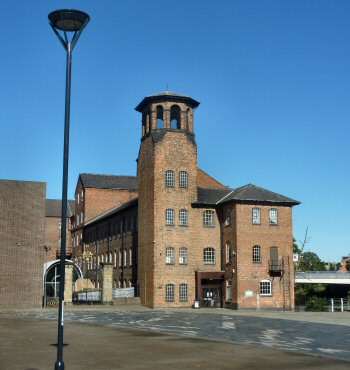SILK MILL, MUSEUM OF MAKING

Former Derby Silk Mill
The Silk Mill’s eye-catching Italian-style tower is a significant landmark in the city. Photographs of it must have appeared in more books and tourist guides about Derby than virtually any other location. Now it forms part of the Derwent Valley Mills World Heritage Site.
The Chinese started to manufacture silk 3,000 years ago. Lovely to the eye and feel, silk has been in demand ever since it was first discovered. Production eventually reached Europe. It was the Italians who first developed a fine silk thread and gained a monopoly in its manufacture.
There was considerable demand for silk in this country. But, the raw materials had to be obtained from China or Italy making it a very expensive commodity. The Italians closely guarded their secret method of production and all the initial attempts to match them failed.
Silk MillIn 1702, Thomas Cotchett, a solicitor from Mickleover, became interested in the potential commercial rewards of silk thread manufacture, by the use of water-driven machinery. He entered the market and reputedly asked George Sorocold to build him a mill by the River Derwent. The mill used ‘Dutch machines’, but the project was not successful.

On the verge of bankruptcy, Cotchett withdrew. But, John Lombe, one of Cotchett’s employees was determined the venture would succeed. Despite the risks involved, he went to Piedmont in Italy. Where silk production was at the forefront, to both work and spy. He drew diagrams of the equipment and is said to have smuggled them back to Britain, inside bales of silk fabric.
He was assisted by his half-brother, Thomas. He set up the Silk Mill, which was built in 1717-8. It was rebuilt in 1821 and again after a fire in 1910. Only the carrying arches and the bell tower remain from the 18th-century structure. The tower only acquired its present appearance, after the 1821 fire. Although some of the brickwork seems to be original. In 1974, Derby’s Museum of Industry and History was opened on the site. Following a major redevelopment the museum reopened as the Museum of Making
The Silk Mill was the first factory in England. Where all the processes were carried out under one roof and utilising one source of power. It is now a Derwent Valley Mills World Heritage Site. John Lombe died in 1722, believed to have been poisoned by a woman. Who had been sent by the Italians to exact revenge for stealing their secrets.’
